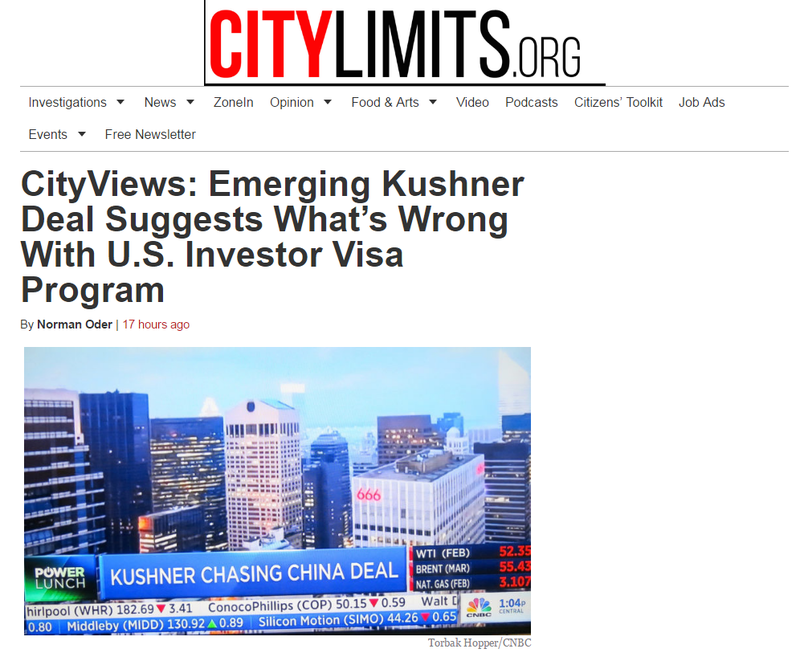CityViews: Emerging Kushner Deal Suggests What’s Wrong With U.S. Investor Visa Program
The emerging partnership between the Kushner Companies and the Chinese insurer Anbang regarding the 666 Fifth Avenue tower in Midtown Manhattan includes a huge payout to Kushner, run by the family of Donald Trump son-in-law Jared, Bloomberg reported. And the deal—fuzzy, if not fantastical—would rely on the controversial EB-5 investor visa program to raise $850 million in low-cost loans to convert office space to luxury condos.
If so it exemplifies the cravenness and sketchiness of EB-5, which is supposed to create ten jobs per $500,000 investor in needy areas, but instead essentially subsidizes developers in prosperous urban zones, often with little hard evidence of job creation. No wonder one New York real estate banker likened EB-5 to “legalized crack cocaine.”
And it also suggests that the Trump administration, resistant to immigration and critical of Chinese business practices, may expand rather than curtail EB-5, which has been the subject of fierce debates in Congress about reform and reauthorization.
What’s wrong with EB-5? Luxury projects in Manhattan raise funds by masquerading as part of high-unemployment zones. Developers use EB-5 though they don’t need the money. Investors get credit for the jobs “created” by the entire project budget, not just their funds. And the job-creation math relies on estimates of indirect jobs, not a head count.
Proposed reforms in Congress regarding some issues might deliver more EB-5 funds to needy projects; some nonprofits, like the Initiative for a Competitive Inner City and the Center for Community Progress, say EB-5 can make a difference. But EB-5, I submit, is so flawed and riddled with dishonesty that it would be wiser to scrap it and re-assess.
If we want to pursue the morally questionable but hardly unique path of selling visas—other major countries demand more of investors—why not auction them off for public purposes, rather than have a trickle-down benefit via the vague job creation? That might cut out many intermediaries profiting from the EB-5 gravy train, including companies recruiting investors and the federally authorized investment pools known as regional centers.
Though the White House told Bloomberg that Kushner would recuse himself from examining EB-5, that’s irrelevant. His mere proximity to the project—plus the participation of Anbang, tied to politically-connected families in China—will be catnip to EB-5 investors from that country, by far the largest source of such investors.
After all, EB-5 promoters regularly bring current or former public officials to help market EB-5 investments, given that signs of government involvement, however tangential, increase confidence among Chinese investors.
Under EB-5, millionaires can get green cards for themselves and their families by parking $500,000 for at least five years in a purportedly job-creating enterprise, via a regional center. They sacrifice investment return because they prioritize getting into the U.S. Aiming to get their money back, they seek projects that seem financially reliable. Aiming to get those green cards, they seek projects that can prove—via an economist’s report—job creation. Project sponsors compete fiercely in China for investors.
No wonder EB-5 promoters enlisted former Gov. David Paterson, state Sen. John Sampson, and City Council Member Larry Seabrook to add a patina of legitimacy to flashy marketing efforts. When New York City Mayor Bill de Blasio met Zhang Yuliang, chairman of the Shanghai-based company that is now the lead investor in the joint venture behind the Atlantic Yards (now Pacific Park) project in Brooklyn, that photo was soon used in EB-5 marketing materials.
Now Charles Gargano, former CEO of the Empire State Development Corporation and Vice Chairman of the Port Authority, serves as Executive Director of U.S. Immigration Fund, helping perhaps the country’s busiest regional center.
This wouldn’t be the first Kushner EB-5 project. The Trump Bay Street luxury apartment tower in Jersey City, NJ, used $50 million in EB-5 funds, about a quarter of the total budget, to lower construction costs. A Kushner spokeswoman, echoing industry rhetoric, told Bloomberg the project was legal and created jobs.
But EB-5 job-creation claims are often as bogus as a Trump University diploma—and there’s new proof. While EB-5 proponents tell Congress that the investments create jobs “at no cost to the U.S. taxpayer,” they talk more candidly among themselves.
Consider the damning admission by Nicholas Mastroianni II, who raised funds for Kushner’s Trump-branded tower and heads the U.S. Immigration Fund, Gargano’s employer. Last November, when asked at a panel in Shanghai how EB-5 could escape allegations of fraud—after some high-profile scams and scandals—Mastroianni advised picking the right project.
“Projects that don’t typically need the capital are the projects that we look to lend money on,” he stated at the session, sponsored by The Real Deal. “If a project can’t be developed without the EB-5 capital, it’s not a project that you should be looking to invest in, because you’ve got a desperate situation.”
That disclosure was dynamite, though not to his audience. After all, if Mastroianni-funded developments like Trump Bay Street, 701 Times Square in Manhattan, and Pacific Park don’t need EB-5 loans, the program has no reason to exist. It just trades visas for profits. Public assets produce no public benefit.
Beyond that, even if EB-5 funds do create jobs, and help projects closer to the public interest (like the Brooklyn Navy Yard, or the New York City Transit wi-fi system), the justification is questionable: rather than “no cost to the American taxpayer,” EB-5 involves a decision to allot public assets. An alternative might deliver more public benefit.
EB-5 has drawn bipartisan support in Congress—Sens. Chuck Schumer (D-NY) and John Cornyn (R-TX) are big proponents—because, hey, who doesn’t like helping local businesses get cheap loans? Meanwhile, real estate developers and EB-5 middlemen shovel cash at Congress. Criticism has emerged from representatives of smaller and more rural jurisdictions, as well as those concerned about fraud and national security threats.
While EB-5 technically requires investors to put up $1 million to create at least 10 jobs, that requirement is halved if the investment is made in a Targeted Employment Area (TEA), which a rural district or a zone of high unemployment. At least, that’s what it’s supposed to be.
In reality, TEA boundaries are routinely, grotesquely gerrymandered, as The New York Times and I separately reported back in 2010, not long after the financial crisis spurred new interest in cheap EB-5 funding. More recently, The Wall Street Journal discovered prosperous Midtown Manhattan preposterously yoked to a Harlem housing project and CityLab similarly tracked a trail from Hudson Yards to East Harlem. Likely a similar map for 666 Fifth Avenue—around the corner from the Museum of Modern Art—will be drawn.
EB-5 job-creation calculations rely not on a common-sense head count of employees but rather a murky “multiplier” keyed to money spent. Consider: when the New York Wheel, a giant planned ferris wheel in Staten Island, sought EB-5 financing, it projected 4,939 jobs. But the Wheel’s own web site claims just 950 jobs.
Using such magical math, the trade group Invest In the USA claimed that EB-5 had “supported over 41,000 U.S. jobs during fiscal year 2013.” By contrast, U.S. Citizenship and Immigration Services (USCIS), the federal agency overseeing EB-5, in February 2016 estimated fewer than 12,000 jobs a year over three fiscal years.
Even that lesser claim is dubious. A federal report in 2013 suggested that regional centers were “greatly exaggerating their indirect and induced job creation figures.” After all, they’ve faced little oversight. USCIS EB-5 head Nicholas Colucci, queried last year by Sen. Chuck Grassley (R-IA), could not specify how many direct (head-count) jobs were created.
Another reason developers love EB-5: immigrant investors get credit for all the jobs created by the project they buy into, even if their stake is paltry.
After an oversight report cited an EB-5 project with 18 percent foreign investment, but with job-creation calculated from the full pot of money, House Judiciary Committee Chairman Rep. Robert Goodlatte, R-VA, said that “makes a mockery of the job creation goal.”
With the first of three Atlantic Yards fundraising efforts, the EB-5 contribution was presented to potential Chinese investors as 17 percent of the total. Though the EB-5 funds did nothing to leverage the direct public subsidies and tax-exempt bonds, the investors still gained job-creation credit from those funds.
A strict reading of the law, observed NYU scholar Gary Friedland, would require projects to demonstrate a link between the EB-5 funds and the jobs, and that investors be credited for jobs based only on the money they put up.
Crediting them with a larger share is justified, Friedland wrote, “only if development and construction of the project would not proceed without EB-5 capital, a position that few project developers could likely demonstrate.” Fundraiser Mastroianni, as illustrated by his comment in Shanghai, surely can’t do so.
Last year, when Sen. Dianne Feinstein (D-CA) asked whether EB-5 could be limited to projects that need the financing, federal official Colucci said it’s not statutorily required.
EB-5 faces an uncertain future, as the regional center program must be reauthorized by April 28. Feinstein and Grassley have submitted a bill to kill the program, earning a Washington Post salute. More likely is jockeying for reform, which previously was resisted by heavyweights like Schumer, responsive to major developers.
Belatedly, the outgoing Obama administration proposed reforms, raising the official EB-5 threshold to $1.8 million, with a lesser discount, to $1.35 million, for projects in Targeted Employment Areas. Analyst Friedland and colleague Jeanne Calderon think that a far smaller increase is likely, such as to $800,000 for TEAs from the current $500,000.
Writing last month, they also suggested the Trump administration might expand the program, currently limited to 10,000 visas per year, by reallocating visas from categories that don’t involve wealthy newcomers. Indeed, given a backlog in applications, perhaps only an expansion of EB-5 would open enough slots for 666 Fifth investors.
Potential EB-5 reforms were the subject of a hearing March 8 by the House Judiciary Committee, where most members criticized the status quo. One pending bill would set aside 4,000 visas for rural and better defined “priority urban investment” areas.
Still, the bill would only modestly rein in job-creation math, requiring that at least ten percent of the jobs be direct, head-count jobs and eliminating the possibility—which, astonishingly, was pursued in Seattle—of immigrant investors parking their money in municipal bonds.
Though proposed reforms would deny a TEA to 666 Fifth Avenue, it’s hard to imagine that EB-5 reauthorization would disadvantage a Kushner project. New York developers have an ally in Schumer, who’s defended EB-5 beneficiaries like the developer Related, arguing that current TEA rules don’t recognize commuter patterns—as if projects in Midtown hire mostly from Harlem.
While Trump has so far reserved comment on EB-5, it’s hard to imagine he’d criticize the program that helped Trump Bay Street and might boost another Kushner project. Regarding 666 Fifth, the immigrant investor angle seems secondary; Bloomberg columnist Timothy O’Brien wrote an essay about Trump-Kushner-Anbang “scandal fatigue” without even getting to EB-5 and the astounding example of a Chinese company benefiting from the sale of U.S. visas to Chinese nationals.
Middleman Mastroianni recently expressed confidence about EB-5. “I don’t think they’re going to criticize the program in any way,” he told The Real Deal. “It’s not bringing over migrant workers, it’s bringing over millionaires.” The question is what, if anything, those millionaires bring with them for American workers and taxpayers.
Mentions
- U.S. Immigration Fund - NJ
- 88 KUSHNER-KABR (Trump Bay Street)
- Atlantic Yards III / Pacific Park
- Hudson Yards Manhattan Tower A-1 - A-8
- Brooklyn Navy Yard Redevelopment Project
- U.S. Citizenship and Immigration Services
- U.S. Immigration Fund, LLC
- The Real Deal
- Nicholas Mastroianni II
- Chuck Grassley
States
- New Jersey
Securities Disclaimer
This website is for informational purposes only and does not constitute an offer or solicitation to sell shares or securities. Any such offer or solicitation will be made only by means of an investment's confidential Offering Memorandum and in accordance with the terms of all applicable securities and other laws. This website does not constitute or form part of, and should not be construed as, any offer for sale or subscription of, or any invitation to offer to buy or subscribe for, any securities, nor should it or any part of it form the basis of, or be relied on in any connection with, any contract or commitment whatsoever. EB5Projects.com LLC and its affiliates expressly disclaim any and all responsibility for any direct or consequential loss or damage of any kind whatsoever arising directly or indirectly from: (i) reliance on any information contained in the website, (ii) any error, omission or inaccuracy in any such information or (iii) any action resulting therefrom.




